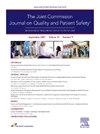Prevention of Central Line–Associated Bloodstream Infections by Leadership Focus on Process Measures
IF 2.4
Q2 HEALTH CARE SCIENCES & SERVICES
Joint Commission journal on quality and patient safety
Pub Date : 2025-02-01
DOI:10.1016/j.jcjq.2024.10.012
引用次数: 0
Abstract
Background
The coronavirus disease 2019 (COVID-19) pandemic affected quality improvement work that was key to hospital-acquired infection (HAI) prevention efforts for many hospitals. Central line–associated bloodstream infection (CLABSI) standardized infection ratios (SIRs) were highly affected by the pandemic.
Methods
After seeing an increase in CLABSI SIRs through early 2021, a health care system including 12 acute care hospitals in the midwestern United States focused on processes and process measures for CLABSI prevention. Each hospital was asked to identify a medical provider, nursing, and infection prevention lead to champion the work (identified as a CLABSI triad). CLABSI triads emphasized best practice expectations, standardized technology and products, and implemented reporting and trending of compliance. Work started in July 2021, with multiple initiatives rolled out through the end of 2022. CLABSI SIRs and standardized utilization ratios (SURs) were analyzed with interrupted time series analysis; changes in several process measures were analyzed using Wilcoxon rank sum exact testing.
Results
A 47.5% decrease was seen in CLABSI SIR through the study period, with SIR = 0.61 from 2023 to April 2024. The slope of the trend line for CLABSI SIR and central line utilization had a significant downward trend in the intervention time frame (p = 0.04 and p < 0.01, respectively). CLABSI prevention best practices improved statistically during the study period.
Conclusion
Intense focus by leadership on key CLABSI prevention process measures was associated with lower CLABSI SIRs.
领导层关注过程措施预防中枢线相关血流感染。
背景:2019年冠状病毒病(COVID-19)大流行影响了许多医院的质量改进工作,而质量改进工作是医院获得性感染(HAI)预防工作的关键。中心静脉相关血流感染(CLABSI)的标准化感染率(SIRs)受到了大流行的严重影响:方法:在 2021 年初 CLABSI SIR 增加之后,美国中西部的一个医疗保健系统(包括 12 家急症医院)将重点放在了 CLABSI 预防的流程和流程措施上。要求每家医院确定一名医疗服务提供者、护理人员和感染预防负责人来支持这项工作(称为 CLABSI 三人组)。CLABSI 三方小组强调最佳实践预期、标准化技术和产品,并实施合规性报告和趋势分析。这项工作于 2021 年 7 月启动,并在 2022 年底前推出多项举措。采用间断时间序列分析法对 CLABSI SIR 和标准化使用率(SUR)进行分析;采用 Wilcoxon 秩和精确检验法对几项流程措施的变化进行分析:在研究期间,CLABSI SIR 下降了 47.5%,从 2023 年到 2024 年 4 月,SIR = 0.61。在干预期间,CLABSI SIR 和中心静脉使用率的趋势线斜率呈显著下降趋势(分别为 p = 0.04 和 p < 0.01)。在研究期间,CLABSI 预防最佳实践在统计上有所改善:结论:领导层对主要 CLABSI 预防流程措施的高度重视与 CLABSI SIR 的降低有关。
本文章由计算机程序翻译,如有差异,请以英文原文为准。
求助全文
约1分钟内获得全文
求助全文
来源期刊

Joint Commission journal on quality and patient safety
HEALTH CARE SCIENCES & SERVICES-
CiteScore
3.80
自引率
4.30%
发文量
116
审稿时长
49 days
 求助内容:
求助内容: 应助结果提醒方式:
应助结果提醒方式:


